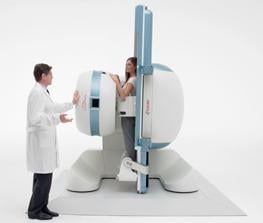
November 27, 2012 — At the 98th annual meeting of the Radiological Society of North America (RSNA) in Chicago, Esaote North America is introducing the new G-scan Brio, a magnetic resonance imaging (MRI) approach for weight-bearing MRI and musculoskeletal applications, which allows clinicians to increase diagnostic accuracy and confidence.
Based on the experience gained from the first generation of G-scan systems, G-scan Brio is a completely renewed weight-bearing MRI system with a new look, new ergonomics and new acquisition techniques. Unlike a multipurpose MRI, all aspects of the G-scan Brio system, from coils to user interface, have been developed and optimized to specifically perform musculoskeletal MRI examinations with a focus on efficiency and patient comfort. Patient setup is easily accomplished by a single operator using a touch-screen display on the gantry that shows real-time images of the joint, assuring fast and accurate positioning.
“The G-scan tilting MRI allows clinicians to study all the joints and the entire spine, either in clinostasis (supine) or in orthostasis (weight-bearing), because magnet and patient can rotate from 0 to 90 degrees. This method has provided several advantages for diagnosis and also for medical-legal aspects,” said Giuseppe Monetti, professor and chair, Department of Diagnostic Imaging “Nigrisoli” United Hospitals, Bologna (Italy) and director of the International School of Musculoskeletal Ultrasound. “In fact, the study of ligamentous structures if performed only in clinostasis doesn’t allow a correct definition of the eventual functional failure of these structures. In orthostasis is almost constant finding: the marked deflection of a ligament, as usually observed in the anterior cruciate ligament. The same concept can be applied in the study of eventual meniscal dislocations, disk herniation, vertebral anterior and posterior listhesis, as well as eventual reactive bone marrow edema, evident exclusively under weight-bearing.”
G-scan Brio is easy to site and very economical to operate. The low break-even point of G-scan Brio is fully in line with the economic constraints of today’s healthcare environment, making it an optimal investment for the private clinic as well. Benefits also include easy installation, ease of use, low maintenance technology, low energy consumption, no cryogens and remote service.
Together with the G-scan Brio, Esaote introduces the new E-MRI Brio Release 2 platform, a combination of acquisition and reconstruction of 2-D sequences that substantially speeds up the MRI examination while emphasizing high image quality. The biggest benefit of this particular technology is the reduction of scan time without compromising image quality.
For more information: www.esaoteusa.com


 December 15, 2025
December 15, 2025 









